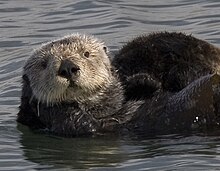 | |
| Sea otter via Wikipedia,org |
| October 09 2015 09:03 AM | Biological Hazard | USA | State of Alaska, Homer [Kachemak Bay] |
RSOE EDIS Event Report
Biological Hazard in USA on Friday, 09 October, 2015 at 09:03 (09:03 AM) UTC.| Description | |
| An unusually high number of dead and dying sea otters have been found in the Kachemak Bay area near Homer this year. Staff from the Alaska SeaLife Center and experts from the U.S. Fish and Wildlife Service are working to figure out what's killing off the otters at such a rapid rate. "More recently, animals have appeared otherwise healthy and seemed to have died very quickly," said Dr. Carrie Goertz, the staff veterinarian at the SeaLife Center in Seward. "They are in good body condition, they have good weight, they have food in their stomach but they wind up dead on the shores." According to Goertz, they've received four times as many reports of sick otters in the past month than they had the same time last year, bringing the 2015 total to more than 200. She said it's typical to see a few die every year from a bacterial infection or trauma. Fish and Wildlife is waiting for test results from necropsies. One cause experts are looking into is the possibility of a toxic algal bloom that's impacted some of the state's shellfish farms. "Otters eat similar things that people eat, and so it's a good idea to investigate that so we understand if it is a harmful algal bloom, if it might be affecting human food resources," Goertz explained. The SeaLife Center's newest sea otter pup is keeping stranding supervisor Halley Werner busy. Without his mom, he needs around-the-clock care. "They literally need to learn every single life skill from mom," Werner explained. "Anything she hasn't taught them before they come to us we need to teach them and make sure they're able to take care of themselves." The still-to-be-named pup is about five to six months old. He came to the facility three weeks ago after he was found with his dying mom on a beach near Homer. "It was really a sad scene. He was more or less guarding her, very fearful of what was going on," Werner said. While experts work to determine a cause, Werner said her staff will be there to help save any otters they can. "We need to do our part of what we can here, caring for the live ones that we can help to recover and do well in an aquarium setting," Werner said. "But it's scary to know there's something out there in the wild that we may or may not be able to do anything about." | |
| Biohazard name: | Mass die-off (sea otters) |
| Biohazard level: | 0/4 --- |
| Biohazard desc.: | This does not included biological hazard category. |
| Symptoms: | |
| Status: | |
Friday, 9 October 2015
Their silence is deafening! Experts are neither confirming or denying Fukushima as responsible for catastrophic deaths as sea otters are the latest species dying in record numbers
Sea otters are the latest species to add to the list of dying marine life and birds along the massive north American coastline stretching all the way from Mexico to Alaska.
Sea otters can now be counted along side fur seals, wales, walrus, dolphins, birds, fish, mussels and starfish dying in catastrophic numbers and the experts don't know why......Or they do and they are not telling us!
It is very interesting experts are neither confirming or denying Fukushima as responsible for the catastrophic deaths!
An unusually high number of dead and dying sea otters have been found in the Kachemak Bay area near Homer this year.
Staff from the Alaska Sea Life Center and experts from the U.S. Fish and Wildlife Service are working to figure out what's killing off the otters at such a rapid rate.
Unusually high number of sea otter deaths reported in Kachemak Bay
An unusually high number of dead and dying sea otters have been found in the Kachemak Bay area near Homer this year.
Staff from the Alaska SeaLife Center and experts from the U.S. Fish and Wildlife Service are working to figure out what’s killing off the otters at such a rapid rate.
“More recently, animals have appeared otherwise healthy and seemed to have died very quickly,” said Dr. Carrie Goertz, the staff veterinarian at the SeaLife Center in Seward. ”They are in good body condition, they have good weight, they have food in their stomach but they wind up dead on the shores.”
According to Goertz, they’ve received four times as many reports of sick otters in the past month than they had the same time last year, bringing the 2015 total to more than 200.
Read More Here
..........


No comments:
Post a Comment
Hello and thank you for visiting my blog. Please share your thoughts and leave a comment :)